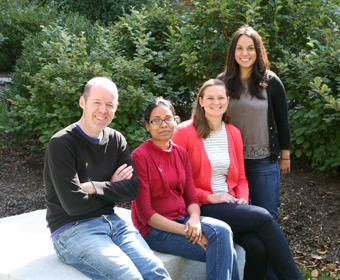(L-R) M. Durney, V. D’Souza, J. Nagle, Carolina Salguero
Retroviruses, like all viruses, rely on host protein machinery to carry out every step in their life cycle. Therefore, while it is expected that retroviruses such as HIV-1 have evolved highly conserved sequences, it is perhaps less appreciated that these sequences often form specific three-dimensional structures to integrate, express and package their minimal RNA genomes. One of the most critical aspects of viral protein synthesis is the very tight regulation of the relative amounts of Gag (the protein mainly responsible for viral packaging at the cell membrane) and Pol (essential for the integration and processing of viral proteins). This ratio is maintained either by ribosomal read-through of a stop codon between the Gag and Pol reading frames in a bicistronic mRNA or,more typically, by using a ribosomal frameshift to translate the downstream Pol reading frame. Both of these mechanisms are well-known examples of ribosomal recoding, which occurs throughout life. Since the Pol gene cannot independently initiate translation, this mechanism ensures that a Gag-Pol fusion and a regular Gag protein are produced at a very well-defined ratio of 1:20, respectively. The mechanism also ensures that the required amount of Pol is packaged into the virus by virtue of being attached to Gag.
In our paper published in Nature we set out to investigate this mechanism by asking how the ratio is so tightly regulated. Another way to think about this question is to simply ask: why does recoding only occur during 5% of translation events?
We focused on the murine leukemia virus (MLV) as a model retroviral system, which utilizes the stop codon as a recoding signal and undergoes ribosomal read-through to produce the Gag-Pol fusion. Recoding events are regulated by downstream RNA structures called pseudoknots, which are positioned to interact with the mRNA entrance channel of the ribosome. Using nuclear magnetic resonance spectroscopy (NMR) we solved the structure of the MLV pseudoknot and uncovered an unusual property of this RNA structure. Since NMR experiments are performed in solution, spectroscopists can investigate how biomolecules respond to changes in conditions. We found that the MLV pseudoknot undergoes a dramatic structural transition as the pH is decreased. A single adenine in the RNA becomes protonated leading to the second, minor conformation of the RNA. At physiological pH, this minor conformation is populated at approximately 6%, which correlates with the level of recoding events. To link this transition to function, we collaborated with the group of Stephen Goff (HHMI, Columbia University) to investigate the effect of pH on recoding of translation of Gag and Gag-Pol.
Surprisingly, we found a very strong correlation as confirmed by several mutations in the sequence predicted to influence the stability of the RNA. This unexpected finding of a structural transition between an inactive form at high pH and an active form at low pH is tuned by the RNA to ensure that recoding occurs at the appropriate level at physiological pH. Protonation causes a chemo-mechanical global structural transition on the RNA to induce the active pseudoknot structure, which is populated at 6%, more or less at the level of Gag-Pol translation. Our findings finally provide an important clue about how recoding actually occurs in the translating ribosome and have implications for future studies on RNA structures in general.
Read more in Nature
[December 1st, 2011]


